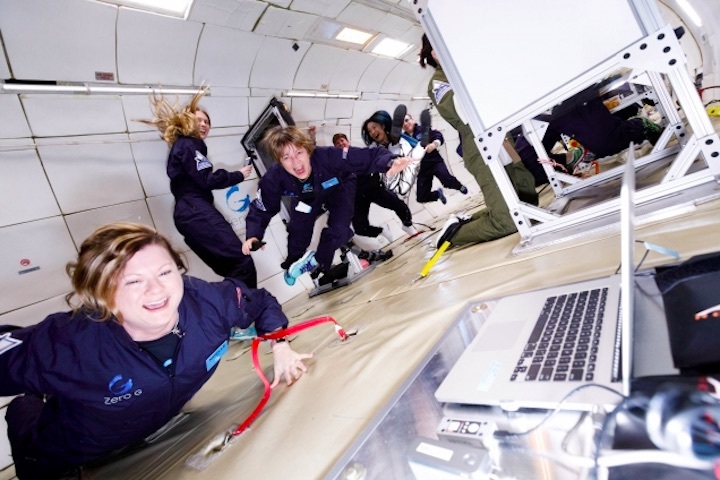27.01.2018

The Media Lab Space Exploration Initiative shares results and next steps from its first zero gravity research mission.
What happens when 20 researchers conduct 14 projects from entirely disparate fields of research over the course of 90 minutes — while floating in zero gravity? Thrills, learning, magic — and results.
This past November, the Media Lab Space Exploration Initiative chartered a flight with the Zero Gravity Corporation to conduct experiments that relied on the unique affordances of microgravity. Projects ranged across disciplines: design, architecture, engineering, biology, music, robotics, and beyond — manifesting the Initiative’s goal of democratizing access to space. On Jan. 23, the group reassembled to share the results of their projects and celebrate the success of the first flight, at a symposium for the MIT community.
“Space used to be for a very small number of people who had to study in a particular field and train for years. But space will soon be for everyone,” says Maria Zuber, MIT’s vice president for research and one of the initiative’s principal investigators. “The Media Lab students bring a creative view, and a lot of out-of-the-box thinking. If we expose those minds to space, we’ll have the benefit of their thinking about facilitating the opening up of the space frontier.”
Rapid prototypes, rapid results
The January symposium demonstrated the remarkable diversity of research areas represented on the flight, and also underscored the far-reaching ideas behind the projects. Even by Media Lab standards it was an unusual assortment, running the gamut from peer-reviewed publications, to architectural modeling, to futuristic fashion. These researchers are imagining and prototyping for humanity's future in space, beyond the basic concerns of survival.
The researchers had only a few weeks to submit project proposals, and between two and five months to design their experiments and get them flight-ready and approved. Every proposal had to meet strict research criteria as well as stringent safety and operational standards. Each experiment had to be designed to run in only 20-30 seconds of zero gravity at a time, over the course of 90 minutes.
The results of the 14 research projects that flew are as varied as their fields of inquiry. A few highlights:
Scratch in Space: Eric Schilling, of the Media Lab’s Scratch team, spent his time in microgravity playing games designed by members of the Scratch community, ages 8-15. He recorded his efforts and compiled them into a video.
TESSERAE: The self-assembling architecture project of Ariel Ekblaw, of the Responsive Environments group, is aimed at a future need for low-cost orbiting space infrastructure. She published the results from the flight as part of a technical paper with AIAA (American Institute of Aeronautics and Astronautics) and presented the paper at their 2018 SciTech conference.
Search for Extra-Terrestrial Genomes (SETG): A project from MIT EAPS, headed by Maria Zuber, SETG is the first experiment to sequence DNA at lunar and Martian gravity. The team published a paper on their results, and are now developing a life-detection device that they hope to send to Mars one day.
Orbit Weaver: Fluid Interfaces group alumna Xin Liu’s Orbit Weaver is a hand-mounted device that shoots out a line and attaches to a surface with a magnet, theoretically allowing her to move with greater control in 3-D space. It’s paired with the Orbit Weaver Suit, a custom flight suit made of reflective material that enhances the performance-art aspect of Liu’s work. The project has been featured in Vice China’s Creators Project.
“I’m incredibly proud of all of the Media Lab projects and Lab students that have contributed,” says Ariel Ekblaw, the initiative’s founder and leader. “A typical zero gravity research flight is about a year in planning. That our participants were able to design and execute their experiments in just a few months really speaks to the culture of the Media Lab, both in terms of rapid prototyping and deployment, and the student-led, grassroots enthusiasm.”
Next steps
At the symposium, Ekblaw also outlined what’s ahead for the Space Exploration Initiative:
-
Annual zero-gravity flight. The flight this past November will be the first of many; the goal is to get as many different projects from as many different research groups and areas of interest up and into zero gravity as possible.
-
Blue Origin flight, summer 2018. Six projects will be selected as payloads for a suborbital flight, allowing for more extended periods of microgravity.
-
International Space Station, winter 2019: One to three payloads will board the ISS, allowing for consistent zero gravity conditions.
Beyond the Cradle
In just a few weeks on March 10, Space Exploration will host its second Beyond the Cradle event, a gathering of students, scholars, and luminaries including astronauts, industry leaders, science fiction visionaries, and researchers. The event will be livestreamed; all are invited to watch and engage in imagining our space future.
Quelle: MIT Massachusetts Institute of Technology
